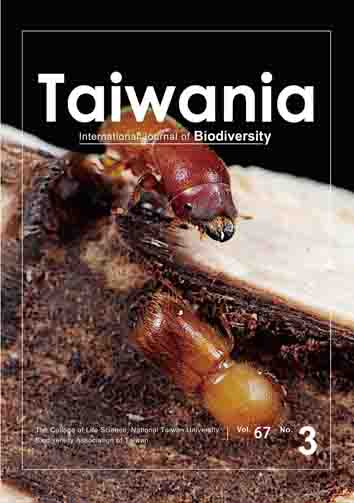Research Paper
Two new species of Pentasacme (Apocynaceae, Asclepiadoideae) from Yunnan, China
Cheng Liu, Xiao-Jian Hu, Jin-Ping Zhang, Wen-Bin Yu, Yun-Hong Tan
Published on: 08 June 2022
Page: 326 - 334
DOI: 10.6165/tai.2022.67.326
Abstract
Pentasacme malipoense C. Liu & Y.H. Tan and P. tubulosum C. Liu, X.J. Hu & Y.H. Tan are two new species from Yunnan, China, which are described and illustrated in this study. Molecular phylogenies using the nrITS, rps16 and trnT-F datasets support these two new species formed a clade in the genus Pentasacme, then as the sister to P. caudatum, which is the only Chinese species hitherto included in phylogenetic studies. Pentasacme tubulosum can be clearly distinguished from the other five recognized species of this genus by its tubular corolla and tube much longer than lobes. Pentasacme malipoense is characterized by having campanulate and deeply lobed corolla, tube much shorter than lobes, corolline coronas present and inverted conical style-head, which is remarkably different from its sister species P. tubulosum. In addition, P. malipoense differs from P. caudatum by the reddish pedicels and calyces, oblong-lanceolate corolla lobes, staminal coronas present and inverted conical style-head, and from P. wallichii and P. shanense by its lanceolate leaf blades, reddish pedicels and calyces, both corolline coronas and staminal coronas present, purple-red anther appendages and inverted conical style-head. Furthermore, for illustrating the two species, diagnostic characters, photographs, morphological descriptions, distribution, and habitat are also provided, as well as the geographical distribution and the diagnostic key to all recognized species of Pentasacme.
Keyword: Apocynaceae, Pentasacme caudatum, P. malipoense, P. shanense, P. tubulosum, P. wallichii, Yunnan, China
Literature Cited
Darriba, D., G.-L. Taboada, R. Doallo and D. Posada. 2012. jModelTest 2: more models, new heuristics and parallel computing. Nat. Methods 9(8): 772.
DOI: 10.1038/nmeth.2109View Article
Google Scholar
Doyle, J.-J. and J.-L. Doyle. 1987. A rapid DNA isolation procedure for small quantities of fresh leaf tissue. Phytochem Bull 19: 11–15.
Endress, M.-E. and P.-V. Bruyns. 2000. A revised classifilcation of the Apocynaceae s.l. Bot. Rev. 66(1): 1–56.
DOI: 10.1007/BF02857781View Article
Google Scholar
Endress, M.-E., S. Liede-Schumann and U. Meve. 2014. An updated classification for Apocynaceae. Phytotaxa 159(3): 175–194.
DOI: 10.11646/phytotaxa.159.3.2View Article
Google Scholar
Endress, M.-E., U. Meve, D.-J. Middleton and S. Liede-Schumann. 2018. Apocynaceae. In: K. Kubitzki (ed.), The families and genera of vascular plants, 15: 207–411, Springer International Publishing AG, Cham, Switzerland.
IUCN. 2019. Guidelines for using the IUCN Red List categories and criteria, version 14. Prepared by the Standards and Petitions Committee. Available from: http://www.iucnredlist.org/documents/RedListGuidelines.pdf (accessed 18 January 2022).
Jin, J.-J., W.-B. Yu, J.-B. Yang, Y. Song, C.-W. dePamphilis, T.-S. Yi and D.-Z. Li. 2020. GetOrganelle: a fast and versatile toolkit for accurate de novo assembly of organelle genomes. Genome Biol. 21(1): 241.
DOI: 10.1186/s13059-020-02154-5View Article
Google Scholar
Katoh, K. and D.-M. Standley. 2013. MAFFT multiple sequence alignment software version 7: improvements in performance and usability. Mol. Biol. Evol. 30(4): 772–780.
DOI: 10.1093/molbev/mst010View Article
Google Scholar
Li, D.-Z. 2020. The families and genera of Chinese vascular plants, vol 3. Science Press, Beijing, China. pp 1830–1831.
Li, P.-T., M.-G. Gilbert and W. Stevens. 1995. Asclepiadaceae. In: Wu, Z.-Y. and P.-H. Raven (eds) Flora of China, 16: 41. Science Press and Missouri Botanical Garden Press, Beijing, China and St. Louis, USA.
Meve, U. and S. Liede. 2004. Subtribal division of Ceropegieae (Apocynaceae-Asclepiadoideae). Taxon 53(1): 61–72.
DOI: 10.2307/4135489View Article
Google Scholar
Meve, U., A. Heiduk and S. Liede-Schumann. 2016. Origin and early evolution of Ceropegieae (Apocynaceae-Asclepiadoideae). Syst. Biodivers. 15(2): 143–155.
DOI: 10.1080/14772000.2016.1238019View Article
Google Scholar
Rahman, M.-A. and C.-C. Wilcock. 1991. A taxonomic revision of the Asiatic genus Pentasacme (Asclepiadaceae). Blumea 36: 109–121.
Ronquist, F. and J.-P. Huelsenbeck. 2003. MrBayes 3: Bayesian phylogenetic inference under mixed models. Bioinformatics 19(12): 1572–1574.
DOI: 10.1093/bioinformatics/btg180View Article
Google Scholar
Stamatakis, A., P. Hoover and J. Rougemont 2008. A rapid bootstrap algorithm for the RAxML web servers. Syst. Biol. 57(5): 758–771.
DOI: 10.1080/10635150802429642View Article
Google Scholar
Surveswaran, S., M. Sun, G.-W. Grimm and S. Liede-Schumann. 2014. On the systematic position of some Asian enigmatic genera of Asclepiadoideae (Apocynaceae). Bot. J. Linn. Soc. 174(4): 601–619.
DOI: 10.1111/boj.12156View Article
Google Scholar
Tobgay, K., N. Gyeltshen, S. Dema, T. Wangchuk and C. Gyeltshen. 2019. Pentasacme wallichii Wight. (Family: Apocynaceae): A first record to Bhutan. Bhutan Journal of Natural Resources & Development 6(1): 27–32.
DOI: 10.17102/cnr.2019.04View Article
Google Scholar
Tsiang, Y. and P.-T. Li. 1977. Asclepiadaceae. In: Tsiang, Y. and P.T. Li. (eds) Flora Reipublicae Popularis Sinicae, 63: 414–415. Science Press, Beijing, China.
Zeng, C.-X., P.-M. Hollingsworth, J. Yang, Z.-S. He, Z.-R. Zhang, D.-Z. Li and J.-B. Yang. 2018. Genome skimming herbarium specimens for DNA barcoding and phylogenomics. Plant Methods 14(1): 43.
DOI: 10.1186/s13007-018-0300-0View Article
Google Scholar


